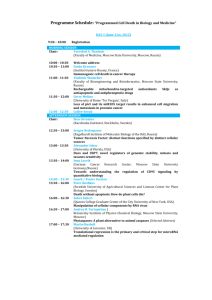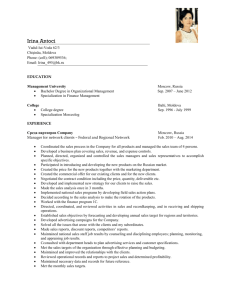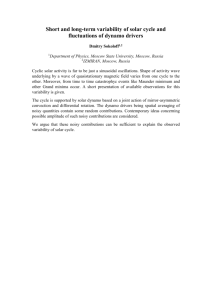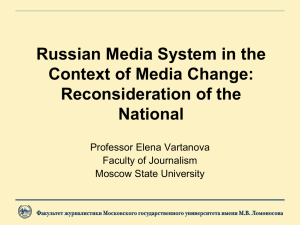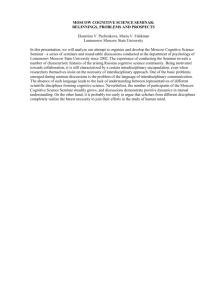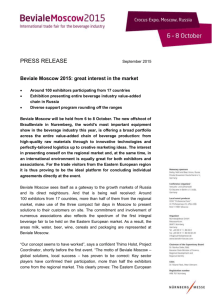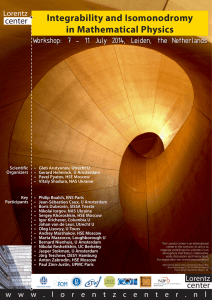The Moscow Landscape: Architecture, Museums and Music
advertisement
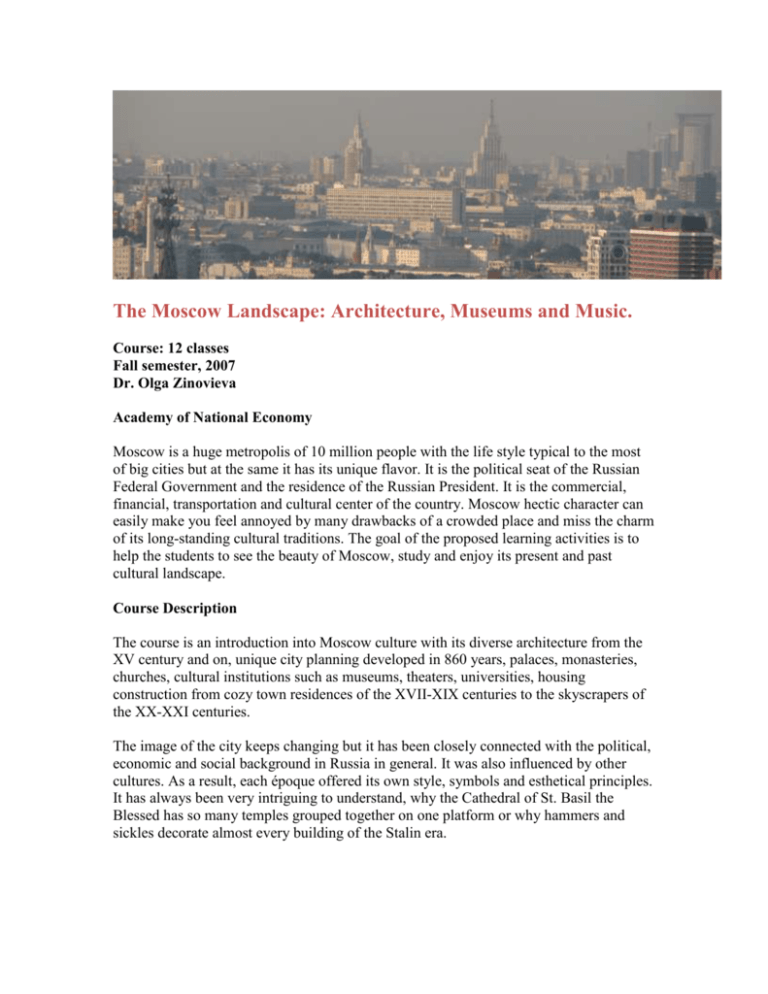
The Moscow Landscape: Architecture, Museums and Music. Course: 12 classes Fall semester, 2007 Dr. Olga Zinovieva Academy of National Economy Moscow is a huge metropolis of 10 million people with the life style typical to the most of big cities but at the same it has its unique flavor. It is the political seat of the Russian Federal Government and the residence of the Russian President. It is the commercial, financial, transportation and cultural center of the country. Moscow hectic character can easily make you feel annoyed by many drawbacks of a crowded place and miss the charm of its long-standing cultural traditions. The goal of the proposed learning activities is to help the students to see the beauty of Moscow, study and enjoy its present and past cultural landscape. Course Description The course is an introduction into Moscow culture with its diverse architecture from the XV century and on, unique city planning developed in 860 years, palaces, monasteries, churches, cultural institutions such as museums, theaters, universities, housing construction from cozy town residences of the XVII-XIX centuries to the skyscrapers of the XX-XXI centuries. The image of the city keeps changing but it has been closely connected with the political, economic and social background in Russia in general. It was also influenced by other cultures. As a result, each époque offered its own style, symbols and esthetical principles. It has always been very intriguing to understand, why the Cathedral of St. Basil the Blessed has so many temples grouped together on one platform or why hammers and sickles decorate almost every building of the Stalin era. The course accompanied by images is built in the historical retrospective but at the same time it covers contemporary themes of the museums, theaters, music, education and crafts. Learning Objectives At the end of the course the students will: Be able to understand the development of different architectural styles in the city in the political, economic and social context. Become familiar with the creators and historians of the city. See old and new portraits of the city Learn about Moscow museums, art galleries, drama and music theaters linked with world practices. Get the skills to find their ways to the places of interest in the city. Develop a general concept of a metropolis, which can be applied to other countries of the world. Course Learning Activities Each class is interactive, which include instructor’s presentations and active discussion by the participants. It will also include a bus tour of the city, a walking tour of Zamoskvorechie historical district and a practical tour of the Prechistinka Street based on students presentations. Final grading will include: Course attendance – 20 % Participation in discussions – 20 % Presentation during the Prechistenka street field exercise. Pending list of classes: 1. 2. 3. 4. Bus tour of Moscow Introduction: What is Moscow? Moscow through the XII-XV centuries The Birth of the City under the Rurik Royal Family. Prince Yury Dolgoruky, the reasons for the appearance of the first fortress. The Medieval Moscow. City planning: why are the streets either circular or redial? The Lost and discovered presence of Prince Daniil, Grand Princes Ivan Kalita and Dmitry Donskoi,. Ivan III and the contemporary Kremlin. Fortresses and monasteries. The centralization of power in the XVI century. The City during Tsar Ivan the Terrible. Pillar shaped cathedrals. The end of the Ruric Family. Boris Godunov and his ambitious plans. From the Troubled Times to the Romanoves. Tzars Mikhail and Alexei. The XVII century split of the church and its consequences for Moscow. Patriarch Nikon. Religious and social paradoxes of the Moscow Baroque/Narishkin style. 5. 6. 7. 8. 9. 10. 11. Emperor Peter the Great, Empresses Katharine I, Anne, Katherine II (Great). Joining Europe and adopting European succession of styles in fine arts and architecture in the XVIII century. European baroque and classical Moscow. Not the capital any more. Resort for the grandees retiring from their service in St. Petersburg. Balls and entertainments. Winter and summer seasons of XVIII century. Elegant Enlightenment and brutal serfdom hand in hand. Town residences and country estates (Kuskovo, Ostankino and others) Profiles of estates. Collections. Serf theaters. Opening of Moscow State University in 1755 and the Bolshoi Theater in 1776. Architects Dmitry Ukhtomsky,Vasilii Bazhenov and Matvei Kazakov Emperors Alexander I, Nicolas I, Alexander II, Alexander III, Nicolas II. Great fire of 1812. The victory over Napoleon celebrated by the Napoleonic Imperial style - Empire. Confrontation between the nobility and the entrepreneurial class as reflected by Moscow architecture. Neoclassical style and Art Nouveau. Technological revolution of the XIX century: enterprises, banks, productions, railways, new town residences, high buildings. The roots of Moscow Contemporary Museums; Music and Drama Theaters. Architects Osip Bovet, Afanasy Grigoriev, Konstantin Ton, Shervud, Fedor Schechtel Walking tour of Zamoskvorechie – the presence and past of the historical district, close to the Kremlin but very isolated. Merchants, entrepreneurs, bankers – superstitious and progressive minded, tight-fisted and generous. Churches, monasteries, fashionable mansions and private collections. A story of 750 years long from a craftsmen village to the headquarters of the wealthiest banks and oil companies. The Revolutions of 1917. Vladimir Lenin and Josef Stalin. Political pluralism and fight for power. Constructivism and Vanguard. Failure to solve social problems through architecture. Workers clubs and communal buildings. Architects Konstantin Melnikov, The Vesnin Brothers, The Golosov Brothers, Alexei Shusev. Totalitarism in architecture. What is Stalin’s Style? Propaganda or dreams in Brick and Stucco. Prewar palaces and postwar temples. Alexei Shusev, Ivan Zholtovsky, Shuko, Gelfreikh, Dmitry Chechulin, Lev Rudnev. Walking tour of Prechistenka Street. Participants prepare 3-5 minute oral presentations about the street (history, architecture, famous people, interesting facts - Character of the Street; Christ the Savoir Cathedral; Metro Station Kropotkinskaya; Monument to Fredrick Engels; The Golovin town residence “Krasnie Palati” (1/2); Belie Palati (3); State Pushkin Literature Museum (Afanasy Grigoriev) (12/2); State Leo Tolstoi Museum (Afanasy Grigoriev) (11); House of Denis Davidov (17); House of the Princes Dolgoruly (Alexandro-Marriinski Institute for noble maids, Military Academy), Museum of Zurab Tsaretelli (19); Academy of Fine Arts (21), The House of Scientists (16), The Ballet School of Aisedora Dunkun (20), The Polivanov Gymnasium (32), Isakov Apartment Building (28) (Lev Kekushev), etc. Contemporary Moscow. Wrap up of the course. Materials 1. 2. 3. 4. 5. 6. 7. 8. 9. Individual maps are requested for each class Any available Guidebook on Moscow or Moscow history book http://www.waytorussia.net/Moscow http://eng.moscowout.ru/ http://www.russianmuseums.info http://www.geographia.com/russia/rusart01.htm http://russia-in-us.com/Religion/Christianity/architec.htm http://www.kreml.ru/en/main/ http://en.wikipedia.org Optional Reading 10. 11. 12. 13. 14. 15. 16. 17. 18. Priscilla Roosevelt. The Life on the Russian Country Estate : A Social and Cultural History Robert K. Massie. Nicholas and Alexandra Robert R. Massie. Peter the Great. Fitzpatrick S. Everyday Stalinism. Ordinary life in extraordinary times: Soviet Russia in 1930-s. "— Oxford University Press, 2000. Guide Rough. Moscow (Guidebook) Adam Zamoyski. Moscow 1812: Napoleon's Fatal March Orlando Figes. Natasha's Dance : A Cultural History of Russia Nicholas V. Riasanovsky, Mark Steinberg. The History of Russia. Maureen Perrie. The Cambridge History of Russia

